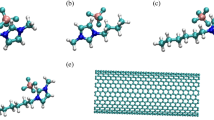Abstract
The network-forming ability of a small fraction of nanosized trianions of the triarylmethyl class (TAM) with poly(diallyldimethylammonium chloride) (PDADMAC) polyelectrolyte is studied by high-field/high-frequency (≈94 GHz) electron paramagnetic resonance spectroscopy. These tristar-shaped organic ions are expected to undergo both electrostatic and hydrophobic interactions with PDADMAC chains. The dependence of electron spin echo (ESE)-detected spectra of the TAM spin probe on PDADMAC concentration reveals a heterogeneous distribution of the spin-carrying counterions. One fraction of these ions forms densely packed clusters while another one is highly diluted. On varying the concentration ratio of TAM spin probe/PDADMAC, the mean distance between closest neighbors within clusters of approximately 1.5 nm does not change significantly, while their fraction increases with decreasing polyelectrolyte content. These findings indicate that the nanosized organic TAM trianions induce network formation in solutions of PDADMAC polyelectrolyte. The data are consistent with a zip-like cooperative binding effect of TAM ions, making this spin probe an interesting building block for electrostatic self-assembly.








Similar content being viewed by others
References
Mark JE (ed) (1982) Polymer networks, advances in polymer science vol 44. Spirnger-Verlag, Berlin Heidelberg New York
Pietralla M, Kilian H-G (eds) (1987) Permanent and transient networks, progress in colloid and polymer science vol 75. Steinkopff-Verlag, Darmstadt
Yan Q, de Pablo JJ (2003), Phys Rev Lett 91:018301–1. DOI 10.1103/PhysRevLett.91.018301
Ogawa S, Decker EA, McClements DJ (2003) J Agric Food Chem 51:2806
Lee SH (2000) Polymer J 32:716
Peppas NA, Huang Y, Torres-Lugo M, Ward JH, Zhang J (2000) Annu Rev Biomed Eng 2:9
Dautzenberg H, Jaeger W, Kötz J, Philip B, Seidel C, Stscherbina D (1994) Polyelectrolytes–formation, characterization and application. Carl Hanser Verlag, Munich
Kötz J, Kosmella S, Beitz T (2001) Prog Polym Sci 26:1199
Rubinstein M, Colby RH (2003) Polymer physics. Oxford University Press
Liu H, Skibinska L, Gapinski J, Patkowski A, Fischer EW, Pecora R (1998) J Chem Phys 109:7556; Skibinska L, Gapinski J, Liu H, Patkowski A, Fischer EW, Pecora R (1999) J Chem Phys 110:1794
Bockstaller M, Köhler W, Wegner G, Vlassopoulos D, Fytas G (2001) Macromolecules 34:6359
Fischer EW (1957) Z Naturforsch 12A:753
Atherton NM (1993) Principles of electron spin resonance. Ellis Horwood, New York
Tsagaropoulos G, Kim JS, Eisenberg A (1996) Macromolecules 29:2222
Hinderberger D, Jeschke G, Spiess HW (2002) Macromolecules 35:9698
Hinderberger D, Spiess HW, Jeschke G (2004) Macromol Symp, in press
Hinderberger D, Spiess HW, Jeschke G (2004) J Phys Chem B 108:9698
Ardenkjaer-Larsen JH, Laursen I, Leunbach I, Ehnholm G, Wistrand LG, Petersson JS, Golman K (1998) J Magn Res 133:1
Yong L, Harbridge J, Quine RW, Rinard GA, Eaton SS, Eaton GR, Mailer C, Barth E, Halpern HJ (2001) J Magn Res 152:156
Schweiger A, Jeschke G (2001) Principles of pulse electron paramagnetic resonance. Oxford University Press
Hinderberger D (2004) Polyelectrolytes and their counterions studied by EPR spectroscopy. Doctoral dissertation, Mainz
Rabenstein MK, Shin YK (1995) Proc Natl Acad Sci 92:8239
Gross A, Columbus L, Hideg K, Altenbach C, Hubbell WL (1999) Biochemistry 28:10324
Dawydoff W, Linow KJ, Philipp B (1991) Acta Polym 42:592; Acta Polym 42:646
Jeschke G, Koch A, Jonas U, Godt A (2002) J Magn Res 155:72
Jeschke G (2002) ChemPhysChem 3:927
Farrar CT, Hall DA, Gerfen GJ, Rosay M, Ardenkjaer-Larsen JH, Griffin RG (2000) J Magn Res 144:134
Jeschke G (2002) Macromol Rapid Comm 23:227
Rees DA (1969) Carbohydr Chem 24:267
Dawydoff W, Linow KJ, Philipp B (1984) Nahrung 28:241
Odijk J (1977) J Polym Sci Polym Phys 15:477; Skolnick J, Fixman M (1977) Macromolecules 10:944
Acknowledgments
We thank Nycomed Innovations AB, Sweden, for generously supplying us with the TAM radical used in this study and C. Bauer for technical support. Financial support from the priority program “High-Field EPR in Biology, Chemistry and Physics” (SPP 1051) by the Deutsche Forschungsgemeinschaft (DFG) is gratefully acknowledged.
Author information
Authors and Affiliations
Corresponding author
Additional information
Dedicated to Professor E.W. Fischer on the occasion of his 75th birthday.
Rights and permissions
About this article
Cite this article
Hinderberger, D., Jeschke, G. & Spiess, HW. Network formation involving polyelectrolytes in solution: the role of counterions. Colloid Polym Sci 282, 901–909 (2004). https://doi.org/10.1007/s00396-004-1117-0
Received:
Accepted:
Published:
Issue Date:
DOI: https://doi.org/10.1007/s00396-004-1117-0




